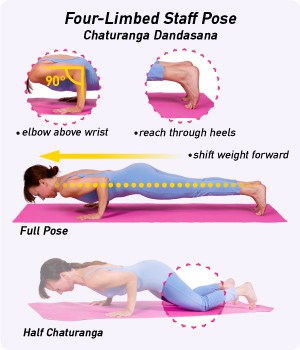
चतुरङ्ग दण्डासन
Chaturanga = four limbs; Danda = staff
Chaturanga or Low plank is the foundation for many sequences of Hatha and Iyengar yoga styles. This pose is also used as a transition pose in the core of vinyasa flows and the Ashtanga series.
How to get into it

- Start in Plank pose. Palms directly under your shoulders, the body is parallel to the floor.
- Engage the core, thighs and push your heels back. On the exhale, slide your body forward until your forearms form a 90° angle with your upper arms.
- Elbows pressed to the core. Gaze down, don’t strain your neck.
- Hold for several seconds, and as you inhale, move to the Upward facing dog.
Benefits
- Strengthens biceps and triceps;
- Improves posture;
- Tones abdominal and back muscles;
- Prepares wrists, shoulders, and palms to handstands and arm balances.
Precautions
Not recommended for those who have a shoulder injury or surgery.
4 Plank Pose Variations for Full-body Training
How to modify it?
Note that beginners may need preps before they can dive into Chaturanga. If you are a beginner, first train your arms, shoulders, and core. You can go through 3 levels increasing the load:
- Use a wall. Stand next to the wall, several inches away from it. Put your palms on the wall, elbows bent and pressed to the sides of your body. Try to push the wall away from you, but keep the whole body activated.
- Improve your strength in high plank and its variations. Side plank and longer time in plank are good options for this.
- Use a more accessible variant of Chaturanga with knees on the floor. You can go for a static pose trying to hold your elbows in line with body sides. Additionally, you can do dynamic pushups with the knees on the floor.
Common mistakes
Sticking buttocks up
Balancing the strength between the upper and lower body, some tend to draw buttocks and hips up in this asana. Such a move puts extra pressure on the lower back and wrists. Thus, try to press your belly button towards the spine and tuck your tailbone.
Also, engage your legs by activating the quadriceps and pushing thighs away from the floor. Don’t let your thighs sage down. In this way, the body weight is distributed evenly between the upper and lower parts.

Leaning shoulders forward
Again, this mistake puts too much load on the wrists and shoulders and can cause injury and chronic pain. To avoid this, pull your shoulder blades away from your ears and engage the abdominal muscles to support the core.